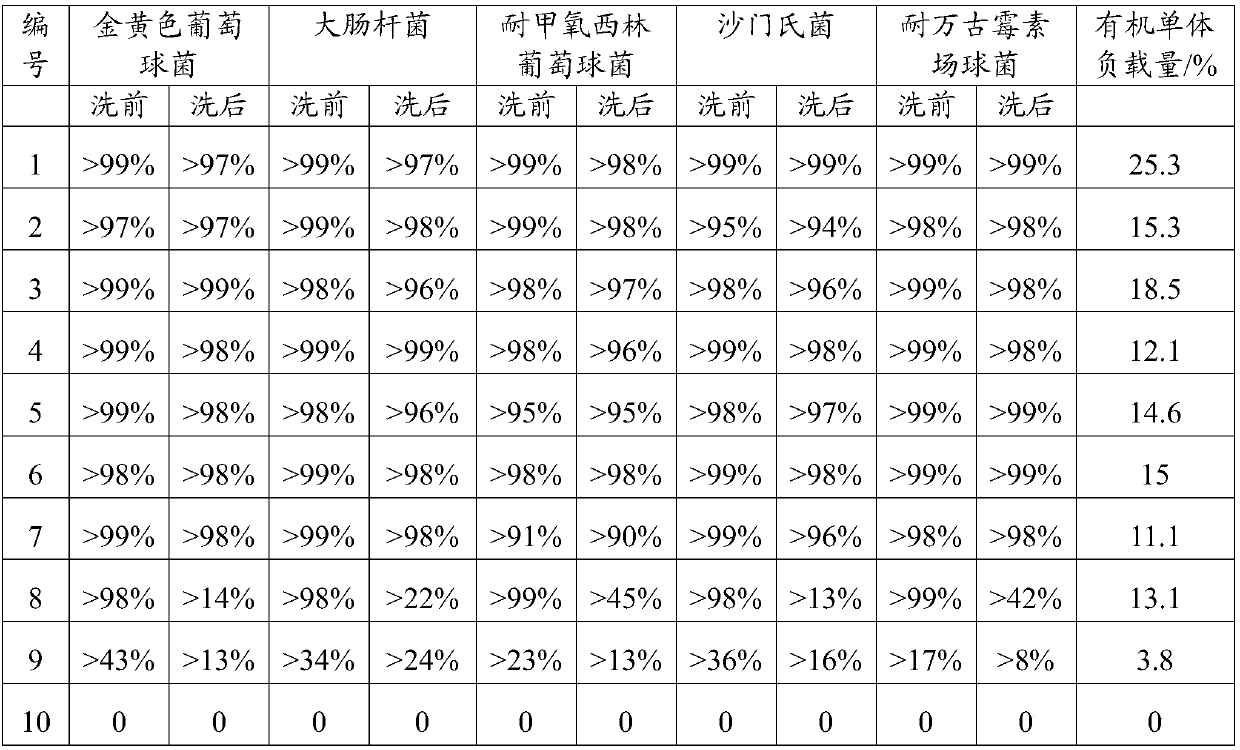Preparation method of quaternary ammonium salt modified antibacterial textile and antibacterial textile
A technology of antibacterial textiles and quaternary ammonium salts, applied in textiles, papermaking, fiber treatment, etc., can solve the problems of easy shedding of antibacterial molecules, affecting the antibacterial performance of textiles, threats to ecological balance, etc., and achieve the effect of simplifying the preparation process
- Summary
- Abstract
- Description
- Claims
- Application Information
AI Technical Summary
Problems solved by technology
Method used
Image
Examples
Embodiment 1
[0019] First, the pure cotton fiber is activated: take 2g of pure cotton fiber and place it in a polyethylene bag, and irradiate the pure cotton fabric with a cobalt 60 radiation source. The absorbed dose of the pure cotton fabric is 80kGy. The irradiation time was 17 hours, and the pure cotton fiber after irradiation was obtained, which was stored in cold storage; secondly, the graft polymerization precursor solution was prepared: 12 mL of dimethylaminoethyl methacrylate and 0.7 mg of sodium lauryl sulfate were added to 60 mL of deionized In an Erlenmeyer flask of water, magnetically stir for 1 hour to mix the solution evenly to obtain a graft polymerization precursor solution; again, carry out a graft polymerization reaction: place the Erlenmeyer flask containing the graft polymerization precursor solution in a water bath, weigh Add 1g of the irradiated pure cotton fiber into the above-mentioned Erlenmeyer flask, completely immerse the irradiated cotton fiber into the graft p...
Embodiment 2
[0021] First, activate the polypropylene fiber: put 2g polypropylene fiber (weight average molecular weight: 300,000) in a polyethylene bag, apply cobalt 60 radioactive source to it for irradiation treatment, the irradiation dose is 90kGy, and the irradiation time After 17 hours, the irradiated polypropylene fiber was obtained and stored in cold storage; secondly, the graft polymerization precursor solution was prepared: 12 mL of dimethylaminoethyl methacrylate and 0.7 mg of sodium lauryl sulfate were added to 60 mL of deionized water In the Erlenmeyer flask, stirred for 1h, the solution was mixed evenly to obtain the graft polymerization precursor solution; again, the graft polymerization reaction was carried out: 1g of the irradiated polypropylene fiber was weighed and placed in a container containing the graft polymerization precursor solution In the Erlenmeyer flask, feed nitrogen into the Erlenmeyer flask, remove the air, continue to feed nitrogen for 20 minutes, stop feed...
Embodiment 3
[0023] First, the polyethylene fiber is activated: 2g polyethylene fiber (weight average molecular weight: 300,000) is irradiated with an electron beam in a nitrogen atmosphere, the irradiation dose is 100kGy, and the irradiation time is 10 minutes, and the irradiation Afterwards, polyethylene fibers were stored in cold storage; secondly, the graft polymerization precursor solution was prepared: 10mL dimethylaminoethyl methacrylate and 0.7mg sodium lauryl sulfate were added to an Erlenmeyer flask containing 60mL deionized water, and stirred 1h, the solution was mixed uniformly to obtain a graft polymerization precursor solution; again, graft polymerization was carried out: 1g of the irradiated polyethylene fiber was weighed and placed in a Erlenmeyer flask containing a graft polymerization precursor solution, Feed nitrogen into the flask, remove the air, continue to feed nitrogen for 20 minutes, stop feeding nitrogen, seal the Erlenmeyer flask, place the Erlenmeyer flask in a w...
PUM
| Property | Measurement | Unit |
|---|---|---|
| Concentration | aaaaa | aaaaa |
Abstract
Description
Claims
Application Information
 Login to View More
Login to View More - R&D
- Intellectual Property
- Life Sciences
- Materials
- Tech Scout
- Unparalleled Data Quality
- Higher Quality Content
- 60% Fewer Hallucinations
Browse by: Latest US Patents, China's latest patents, Technical Efficacy Thesaurus, Application Domain, Technology Topic, Popular Technical Reports.
© 2025 PatSnap. All rights reserved.Legal|Privacy policy|Modern Slavery Act Transparency Statement|Sitemap|About US| Contact US: help@patsnap.com


